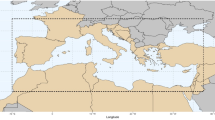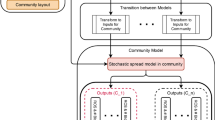Abstract
During the last decades the Mediterranean zone in Europe has experienced an increment in the incidence of forest wildfires. This increase is partly explained by higher mean temperature and lower relative humidity, while socioeconomic change has lead to the abandonment of farms, resulting in an increase in an unusual accumulation of forest fuels, increasing the risk of wildfires. Mapping wildfire risk is highly important because wildfires are known to potentially lead to landscape changes and to modify fire regime by inducing potential changes in vegetation composition. Also, they pose a hazard to human property and life. Maps of wildfire risk based on statistical models provide a measure of uncertainty for the inferences derived from such risk maps, leaving a quantitative error margin for managers and decision takers. Further, some of the model parameters often have a physical or a biological interpretation which can give ecologists and forest engineers answers about scientific questions of interest. In this paper, we analyze the incidence of wildfires in the province of Castellón in Spain in order to identify risk factors associated with wildfire incidences during the years 2001–2006. We used the discrete nature of wildfire events to build such models using point process theory and methods and included information about elevation, slope, aspect, land use and distance to nearest road as covariates in our modeling process. Our results show that wildfire risk in Castellón is associated with all the covariates considered and that three land-use categories have the highest risk of wildfire incidence. Also, wildfire incidences are not independent and some degree of interaction exists, which indicates that the commonly used Poisson point process models are not applicable in this case, but instead area-interaction models should be considered.









Similar content being viewed by others
References
Amatulli G, Peréz-Cabello F, De la Riva J (2007) Mapping lightning/human-caused wildfires occurrence under ignition point location uncertainty. Ecol Model 200(3–4):321–333
Baddeley A, van Lieshout MNM (1995) Area-interaction point processes. Ann. Inst. Statist. Math. 47:601–619
Baddeley A, Turner R (2005) Spatstat: an R package for analyzing spatial point patterns. J Stat Softw 12:1–42
Baddeley A, Turner R, Moller J, Hazelton M (2005) Residual analysis for spatial point processes. J R Stat Soc B 67(5):617–666
Baddeley A, Turner R (2000) Practical maximum pseudolikelihood for spatial point processes. N Z J Stat 42:283–322
Barbero R, Abatzoglou JT, Steel EA, Larkin NK (2014) Modeling very large-fire occurrences over the continental United States from weather and climate forcing. Environ Res Lett 9:1–11
Barros AMG, Pereira JMC (2014) Wildfire selectivity for land cover type : does size matter? PLoS One 9(1):e84760. doi:10.1371/journal.pone.0084760
Bastarrika Izagirre A, Chuvieco Salinero E (2006) Cartografía del área quemada mediante crecimiento de regiones: aplicación en entornos mediterráneos con imágenes tm y etm+. GeoFocus 6:182–204
Caballero D, Beltran I, Velasco A (2007) Forest fires and wildland-urban interface in Spain: types and risk distribution. In: Proceedings of the IV international wildfire conference, Seville, Spain
Carmo M, Moreira F, Casimiro P, Vaz P (2011) Land use and topography influences on wildfire occurrence in northern Portugal. Landsc Urban Plan 100:169–176
Cressie NAC (1993) Statistics for spatial data, Revised edn. Wiley, New York
de la Riva J, Pérez-Cabello F, Lana-Renault N, Koutsias N (2004) Mapping forest fire occurrence at a regional scale. Remote Sens Environ 92(3):363–369
Díaz-Avalos C, Alvarado CE (1998) Space-time analysis of fire pattern in the Blue Mountains, Oregon. In: En Weber R (ed) 13th Fire and forest meteorology conference. Lorne Australia October 27–31, 1996. International Association of Wildland Fire, pp 413–420
Díaz-Avalos C, Peterson DL, Alvarado E, Ferguson SA, Besag JE (2001) Space-time modelling of lightning-caused ignitions in the Blue Mountains, Oregon. Can J For Res 31(9):1579–1593
Diggle PJ (2003) Statistical analysis of spatial point patterns, 2nd edn. Arnold, London
European Environment Agency (2007) Technical report No 17/2007. CLC2006 technical guidelines. Office for Official Publications of the European Communities, Luxembourg
González JR, Palahi M, Trasobares A, Pukkala T (2006) A fire probability model for forest stands in Catalonia (north-east Spain). Ann For Sci 63:169–176
Grabarnik P, Myllymäki M, Stoyan D (2011) Correct testing of mark independence for marked point patterns. Ecol Model 222:3888–3894
Hanewinkel M, Hummel S, Albretch A (2006) Assessing natural hazards in forestry for risk management: a review. Eur J For Res 130:329–351
Hardy CC (2005) Wildland fire hazard and risk: problems, definitions, and context. For Ecol Manag 211:73–82
Heymann Y, Steenmans CH, Croissille G, Bossard M (1994) CORINE land cover. Technical guide. Office for Official Publications of the European Communities, Luxembourg
Hutchinson TF, Sutherland EK, Yaussy DA (2005) Effects of repeated prescribed fires on the structure, composition, and regeneration of mixed-oak forests in Ohio. For Ecol Manag 218(1–3):210–228
Illian J, Penttinen A, Stoyan H, Stoyan D (2008) Statistical analysis and modelling of spatial point patterns. Wiley, West Sussex
Juan P, Mateu J, Saez M (2012) Pinpointing spatio-temporal interactions in wildfire patterns. Stoch Environ Res Risk Assess. doi:10.1007/S00477-012-0568-y
Koutsias N (2003) An autologistic regression model for increasing the accuracy of burned surface mapping using Landsat Thematic Mapper data. Int J Remote Sens 24(10):2199–2204
Koutsias N, Kalabokidis KD, Allgöwer B (2004) Fire occurrence patterns at landscape level: beyond positional accuracy of ignition points with kernel density estimation methods. Nat Resour Model 17(4):359–375
Koutsias N, Xanthopoulos G, Founda D, Xystrakis F, Nioti F, Pleniou M, Mallinis G, Arianoutsou M (2013) On the relationships between forest fires and weather conditions in Greece from long-term national observations (1894–2010). Int J Wildland Fire 22(4):493–507
Martínez-Fernández J, Chuvieco E, Koutsias N (2013) Modelling long-term fire occurrence factors in Spain by accounting for local variations with geographically weighted regression. Nat Hazards Earth Syst Sci 13(2):311–327
Mateu J, Uso JL, Montes F (1998) The spatial pattern of a forest ecosystem. Ecol Model 108:163–174
Ministerio de Medio Ambiente (2006) Los incendios forestales en España. Decenio 1996–2005
Møller J, Waagepetersen RP (2007) Modern statistics for spatial point processes (with discussion). Scand J Stat 34:643–711
Møller J, Díaz-Avalos C (2010) Structured spatio-temporal shot-noise Cox point process models, with a view to modelling forest fires. Scand J Stat 37:2–15
Moreira F, Viedma O, Arianoutsou M, Curt T, Koutsias N, Rigolot E, Barbati A, Corona P, Vaz P, Xanthopoulos G, Mouillot F, Bilgili E (2011) Landscape–wildfire interactions in southern Europe: implications for landscape management. J Environ Manag 92:2389–2402
National Interagency Fire Center (2011) The science of wildland fire. http://www.nifc.gov/)
Pausas JG (2004) Changes in fire and climate in the eastern Iberian Peninsula (Mediterranean basin). Clim Change 63:337–350
Preisler HK, Westerling AL (2007) Statistical model for forecasting monthly large wildfire events in western United States. J Appl Meteorol Climatol 46:1020–1030
R Development Core Team (2010) R: a language and environment for statistical computing. R Foundation for Statistical Computing. http://www.r-project.org/
Ripley BD (1976) The second-order analysis of stationary point processes. J Appl Probab 13:256–266
Ripley BD (1981) Spatial statistics. Wiley, New York
Serra L, Varga D, Juan P, Saez M, Mateu J (2014) Spatio-temporal log-Gaussian Cox processes for modelling wildfire occurrence: the case of Catalonia, 1994–2008. Environ Ecol Stat 21(3):531–563
Turner R (2009) Point patterns of forest fire locations. Environ Ecol Stat 16:197–223
Vázquez A, Moreno JM (1998) Patterns of lightning-, and people-caused fires in peninsular Spain. Int J Wildland Fire 8(2):103–115
Vilar del Hoyo L, Martin Isabel MP, Matinez Vega FJ (2011) Logistic regression models for human-caused wildfire risk estimation: analyzing the effect of the spatial accuracy in fire occurrence data. Eur J For Res 130:983–996
Waagepetersen RP (2007) An estimating function approach to inference for inhomogeneous Neyman–Scott processes with appendix. Biometrics 63:252–258
Wittenberg L, Malkinson D (2009) Spatio-temporal perspectives of forest fires regimes in a maturing Mediterranean mixed pine landscape. Eur J For Res 128:297–304
Acknowledgments
We would like to thank the Department of Infrastructure Territory and Environment of the Generalitat Valenciana, Section of Forest Fire Prevention, for the assignment of geographic data.
Author information
Authors and Affiliations
Corresponding author
Additional information
Handling Editor: Dr. Hans Pretzsch.
Rights and permissions
About this article
Cite this article
Aragó, P., Juan, P., Díaz-Avalos, C. et al. Spatial point process modeling applied to the assessment of risk factors associated with forest wildfires incidence in Castellón, Spain. Eur J Forest Res 135, 451–464 (2016). https://doi.org/10.1007/s10342-016-0945-z
Received:
Revised:
Accepted:
Published:
Issue Date:
DOI: https://doi.org/10.1007/s10342-016-0945-z




